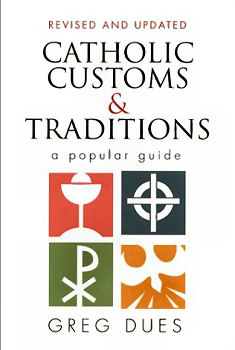
|
Posted May 16, 2010
Book: Catholic Customs and Traditions: a Popular Guide Author: Greg Dues Twenty-Third Publications. Mystic, CT. 1989. Pp. 214 An Excerpt from the Jacket:
These are but a few of the myriad elements of Roman Catholic traditions and customs explored and explained in this comprehensive volume. While discussing the vast changes in Catholic cultic practices following Vatican II, Greg Dues demonstrates that traditions have always been “subject to change,” and are influenced by societal as well as ecclesial developments. He then highlights the social and religious backdrops to the most significant religious practices in the Catholic heritage. Dues provides an engaging overview of the rich variety of traditions associated with Advent, Christmas, Lent, Holy Week, and Easter, and places in perspective the veneration of Mary and the saints. Also treated are the sacraments, popular devotions, and traditions not directly associated with the church year, such as Halloween and Thanksgiving. The select bibliography and index will help readers further delve into the rich religious legacy of the Catholic church. An Excerpt from the Book: Poinsettia The poinsettia with its scarlet leaves, now of many hues, came from Mexico where it grows as a shrub. It blooms at Christmastime, and Mexicans called it “flower of the Holy Night.” It was brought to the United States by the first U.S. ambassador to Mexico, Dr. Joel Roberts Poinsett (1779-1851) who had them grown in his greenhouse in South Carolina. Eventually, they were named after him. Only since 1920 have they become potted plants. Poinsettas are now associated as much with Christmas as lilies are with Easter. Pentecost The Easter season lasts for fifty days, ending with Pentecost (from the Greek pentekoste, “fiftieth”). Ranking second only to Easter, the feast of Pentecost must be understood in the context of the Jewish feast by the same name. Its other name in Jewish tradition is Feast of Weeks, a full season of seven weeks of thanksgiving beginning with Passover Sabbath (see Tobias 2:1; 2 Macabees 12:32). This prolonged festival celebrated the theme of harvest and thanksgiving. It evolved before the time of Christ into a memorial of the covenant and, by 300 C.E., a memorial of the giving of the Law. By the end of the 2nd century, Christians were observing a similar fifty day festival of rejoicing after the annual Pascha. It seems that originally the followers of Jesus continued to observe the Jewish festival, a time of “first fruits” (see 1 Corinthians 16:8 and 15:20, 23) rather than a distinctly new theme. During these weeks, fasting and kneeling were forbidden because of the joyful experience of resurrection. By the late 4th century, the feast of the Ascension was celebrated in some parts of the church on the fortieth day after Easter (see Acts 1:3, 9-11). Originally, this mystery of the ending of Jesus’ visible presence among his followers seems to have been observed as part of the outpouring of the Spirit on the 50th day, or Pentecost. For the first time, the original 50-day festival was broken. The weekdays between the Ascension and Pentecost are a preparation period for the outpouring of the Spirit. It is popularly called the Pentecost Novena (see Acts 1:14). Pentecost itself closes out the Easter season. It celebrates the overwhelming experience of God pouring out the Spirit upon the first community of those who believed Jesus was the Lord and Christ (see Acts 2:1-4). Pentecost is called, therefore, the birth of the church or the birth of the church’s mission. The color of vestments and decorations for Pentecost is red. It symbolizes the intense love and fire of the Holy Spirit. Other symbols of the Pentecost event are the dove (see Luke 3:21-22), the tongues of flame (see Acts 2:1-4), and wind (see Acts 2:2). Table of Contents 1. The nature of religious traditions 2. The church year 3. Sunday 4. Weekdays 5. Seasons 6. Advent 7. Christmas 8. Christmastime 9. Lent 10. Holy Week 11. The Easter vigil 12. Easter 13. Ordinary time 14. Communion of saints 15. Mary 16. Purgatory 17. Popular saints and legends 18. Sacramentals 19. Halloween and Thanksgiving |
|
